One of the most crucial decisions you will need to make is choosing the right generator to power your culinary masterpiece on wheels. In this article, we will guide you through the process of selecting the perfect generator for your needs. So fasten your seat belts, because we’re about to rev up the power!
Understanding Your Power Needs
Before you dive into the wide world of generators, it’s important to understand your power needs. Consider the appliances and equipment you plan to install in your food truck or trailer. Are you dreaming of a deep fryer that can cook up a mountain of crispy fries? Or perhaps a commercial-grade refrigerator to keep your ingredients fresh? Whatever your power-hungry desires may be, make a list of the electrical requirements of each device.
This will serve as the foundation for calculating your total power draw. Let’s start with the deep fryer. Picture the sizzle of golden fries being lowered into a bubbling sea of oil, their aroma filling the air. To achieve this, you’ll need a deep fryer with a heating element that consumes a significant amount of power (assuming it is an electric deep fryer – at Mile High we prefer using propane/LP based cooking equipment over electric but that’s a discussion for another day).
Now, let’s move on to the commercial-grade refrigerator. Imagine opening its sturdy doors to reveal shelves filled with fresh produce, dairy products, and other perishable ingredients. To keep these items at the optimal temperature, you’ll need a refrigerator with a powerful compressor. Take note of the wattage required to run the compressor and maintain the desired temperature range.
But wait, there’s more! Don’t forget about other appliances and equipment that may be essential to your food truck or trailer’s operation. Consider the power requirements of your ventilation system, lighting fixtures, cash register, and any other electrical devices you plan to use. Each of these components adds to your overall power draw and should be accounted for in your calculations. Now that you have a comprehensive list of the electrical requirements for each device, it’s time to crunch some numbers. Add up the wattage of all the appliances and equipment to determine your total power draw. Remember, it’s always better to overestimate your power needs than to fall short. Running out of power in the middle of a busy day can be disastrous for your business. If you were to under estimate the power requirements, one of your appliances will overdraw on power and the rest of your appliances will run at a lower voltage which is potentially bad for the appliance or can trip the breaker, not something you want to happen when there is a line of hungry customers awaiting their tacos. So take the time to understand your power requirements and choose a generator that can handle the load. With the right generator by your side, you’ll be able to power your culinary dreams and serve up delicious dishes to your eager customers.
Calculating the total power draw for your build
Now that you have a comprehensive list of your electrical needs, it’s time to do some number crunching. Add up the wattage of each appliance and equipment, and don’t forget to account for any future additions you might have in mind.
You can do this by getting the spec sheet of every piece of equipment you plan to use, identifying its wattage in it and adding up with the rest of your Bill of Materials.
For example, this espresso machine draws 4700W.
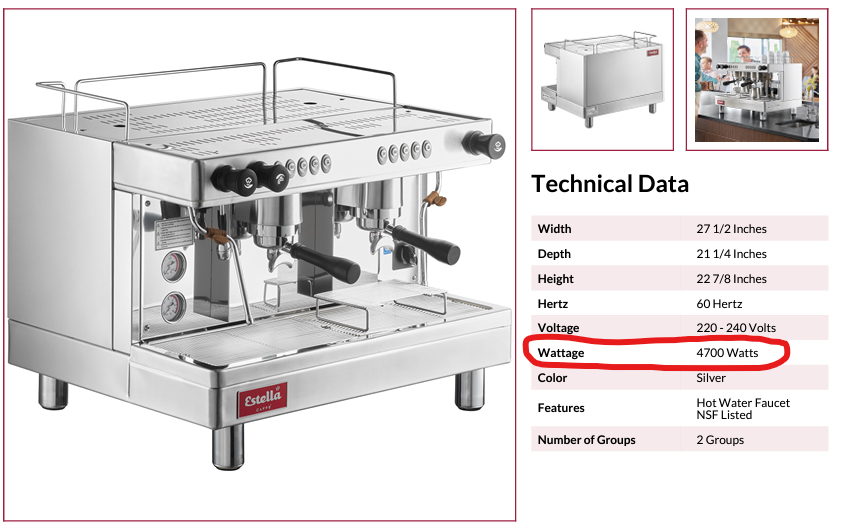
Now some manufacturers do not have wattage in their spec sheets. We can use Ohm’s law to calculate the wattage in those cases, sort of.
Ohm’s law states that Power (in Watts) = Voltage (in Volts) x Current (in Amperes)
So conversely, the above espresso machine should draw 21.36Amps. Well not exactly, you see a water heater for example can be assumed to have a power factor or efficiency of 1, in other words it converts all the power it consumes to heat. It’s not the same with for example a refrigerator, which is why those manufacturers sometimes don’t share the wattage.
That being said we are looking to select a generator for a food truck or food trailer not land on moon. So the assumed wattage or VA is good enough for us. On a side note this is why generators measure their output in VA or kVA instead of Watts.
Let’s start by considering the wattage of your refrigerator. On average, a standard refrigerator consumes around 1200 watts per day. However, this can vary depending on the size and energy efficiency of your specific model. It’s always a good idea to check the manufacturer’s specifications to get an accurate wattage value. Next, let’s move on to your air conditioning unit. The power draw of an AC unit can vary significantly depending on its size and cooling capacity. A split A/C unit typically consumes around 500-700 watts, while an RV AC unit with heating can use anywhere from 1000 to 1500 watts. Keep in mind that these values are approximate and can vary based on factors such as the outside temperature and the desired indoor temperature
Now, let’s consider your lighting needs. If you’re using LED bulbs, they typically consume around 8-10 watts per bulb. However, if you’re using traditional incandescent bulbs, they can consume anywhere from 40 to 100 watts per bulb. Take into account the number of bulbs you have in your unit to get an accurate estimate of your lighting power draw.
Don’t forget about TV units or Awnings! If you have a television, it can consume anywhere from 80 to 400 watts, depending on its size and energy efficiency. Awnings, typically consume around 40-100 watts when they are being actuated. If you have a PA system with speakers and a subwoofer, they can add an additional 100-500 watts to your power draw.
Lastly, let’s consider any additional appliances or equipment you may have, such as a microwave, dishwasher, or a dishwasher. Microwaves typically consume around 1000-1500 watts, while dishwashers and washing machines can use anywhere from 1200 to 2400 watts, depending on their size and energy efficiency.
Keep in mind that some appliances have a higher starting wattage, so consider this in your calculations. For example, a refrigerator may require up to three times its normal wattage when starting up. This surge in power is necessary to kick start the compressor. Make sure to account for these starting wattages to ensure your generator can handle the initial power surge.
Once you have the total wattage of all your appliances and equipment, you’ll have a better idea of the generator size required to handle your power-hungry ambitions. It’s always a good idea to add a buffer of around 20% to your total wattage to account for any unexpected power spikes or future additions to your electrical needs.
Determining the Best Fuel Source for Your Generator
When it comes to fuel sources for generators, you have some options to consider. Gasoline, propane, and diesel are the most common.
Each fuel source has its pros and cons, so it’s essential to weigh them carefully. Consider factors such as availability, cost, and maintenance requirements. Gasoline may be more readily available, but propane and diesel can often provide more fuel efficiency and longer runtime.
Let’s start by discussing gasoline as a fuel source for generators. Gasoline is widely available, making it convenient for most users. You can find gasoline at almost any gas station, making it easy to refill your generator whenever needed. However, gasoline can be expensive, especially during times of high demand or during emergencies when prices tend to spike. Additionally, gasoline has a shorter shelf life compared to other fuel sources, so it’s crucial to rotate your supply regularly to ensure its freshness. If you have a Gasoline powered food truck we at Mile High custom Foodtrucks can tie the fuel line of the truck to the generator, so you don’t have to fill the generator separately.
Now, let’s move on to propane as a fuel source for generators. Propane offers several advantages over gasoline. Firstly, propane is typically cheaper than gasoline, making it a more cost-effective option in the long run. Secondly, propane has a longer shelf life, allowing you to store it for extended periods without worrying about degradation. This is particularly useful for those who live in areas prone to natural disasters or power outages. Lastly, propane is cleaner-burning than gasoline, resulting in fewer emissions and less pollution. However, propane may not be as readily available as gasoline, so it’s essential to plan ahead and ensure you have a sufficient supply. In cases where we are using Cummins and PowerTech generators, we at Mile High custom food trucks are able to tie the propane tanks that you are using for cooking to the generator, so you don’t need a separate tank for it.
Lastly, let’s explore diesel as a fuel source for generators. Diesel is known for its fuel efficiency and longer runtime. It can provide more power output per gallon compared to gasoline or propane, making it an excellent choice for heavy-duty applications or prolonged use. Diesel fuel also has a longer shelf life, similar to propane, allowing for easy storage and peace of mind. However, diesel fuel can be more expensive than gasoline, and it may not be as widely available in certain areas. Just like with Gasoline or propane we are able to tie the fuel tank of the truck to the generator so you are able to fill just one tank and go on your way.
Alternatively, should you have a Gasoline truck and choose a diesel generator, we add an auxiliary tank to store diesel. Like in the photos below:
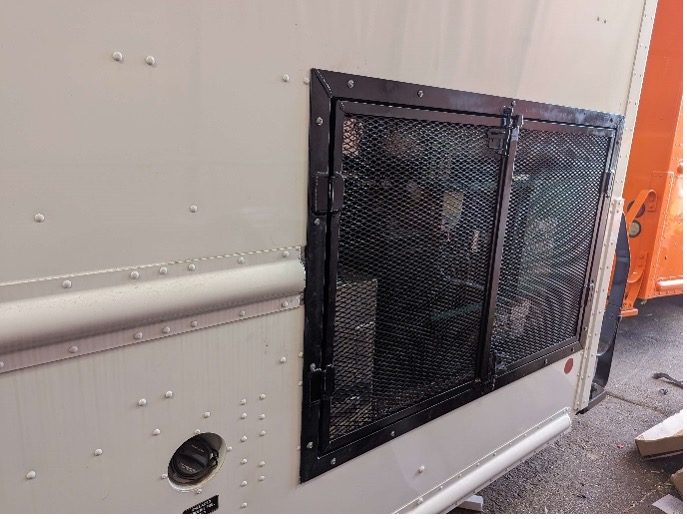
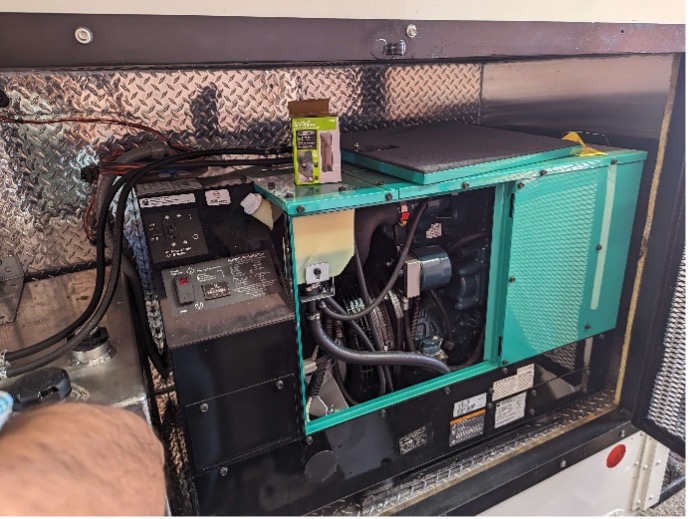
When deciding on the best fuel source for your generator, it’s crucial to consider your specific needs and circumstances. If you require a fuel source that is readily available and convenient, gasoline may be the right choice for you. On the other hand, if cost-effectiveness, longer shelf life, and cleaner emissions are important to you, propane might be the way to go. And if you need a fuel source that offers fuel efficiency and extended runtime, diesel could be your best bet. Choose wisely, young food truck Jedi, and may the force be with you in finding the perfect fuel source for your generator!
How to Install a Generator in Your Food Truck or Trailer
Now that you have chosen the perfect generator, it’s time for the installation process. But where should you mount this beast of power?
Two popular options are tongue mounted generators (only in case of food trailers) and side mounts. The tongue mount may save space inside your food trailer, but the side mount offers easier access for maintenance. Consider the layout and design of your vehicle to decide which option suits you best.
Another advantage of the tongue mount (only applicable in case of a trailer of course) is that it will help with the tongue weight of the trailer – about 10 to 15% of the vehicle mass should be on the tongue for it to pull really well.
Tongue weight and weight distribution are very important topics that are slightly out of the scope here and are better addressed in this blog: https://www.zionfoodtrucks.com/blog/how-to-build-a-foodtruck-or-trailer-that-tows-well
And these two videos:
https://www.youtube.com/watch?v=w9Dgxe584Ss
https://www.youtube.com/watch?v=6mW_gzdh6to
But wait, there’s more to consider! What about shore power availability? Will you always be able to plug into an electrical outlet, or will your generator be your sole source of power? These are the questions that keep food truck builders up at night. Plan accordingly and ensure your generator can handle both on-the-go power and shore power compatibility. Stay flexible!
Noise vibration and harmonics issues
No one wants their food truck or trailer to be accompanied by the continuous drone of a generator. Noise, vibration, and harmonics can be a significant concern, not only for yourself but also for your customers. Look for generators designed to minimize noise and vibrations. This Cummins generator for example is mounted on a thick plate which is floated on springs, reducing the vibrations transmitted to the truck.
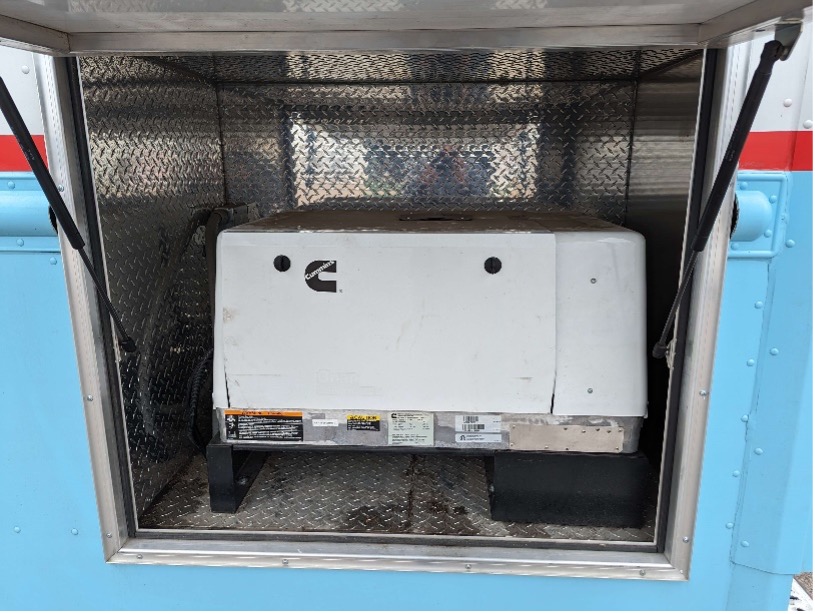
We always prefer to use double or triple axel trailers wherever we can, because they have more than one or two points to transmit the vibrations away from the trailer, allowing for better vibes.
Another thing we do at Mile High is to always mount the generator on the opposite side of the service window in case it is a food truck, this way the truck is between the customer and the generator, keeping the noise much lower at the service window.
Your taste buds will thank you, and your customers’ eardrums will sing with joy!
Routing the exhaust away from the generator box
Now, this might sound like a no-brainer, but hear us out. It’s essential to route the exhaust fumes away from your generator box and, more importantly, away from your food. You don’t want that smoky flavor to come from your generator, do you? Make sure your exhaust system is properly installed and vented. Safety first, folks!
We recently had a food truck brought in for repair that didn’t have the exhaust installed – the carbon monoxide sensor in the generator was turning the generator off and the generator itself was overheating due to lack of ventilation, don’t do this my good people. Install that exhaust and pipe the fumes away from the foodtruck.
Theft/security concerns
Criminals can have some pretty strange tastes. While your delicious dishes might be their main squeeze, don’t underestimate the allure of a generator. These power-packed machines can be magnets for theft. Consider security measures such as locks, alarms, and even camouflage to keep your generator safe and sound. Because nobody wants their food truck dream to vanish into thin air
Cummins, PowerTech, Honda vs Predator
Finally, the moment of truth has arrived. Which generator brand will reign supreme in your food truck empire? Cummins? PowerTech? Honda? Or maybe the mighty Predator? Each brand has its loyal following and unique features. Research customer reviews, compare specifications, and let your gut (and budget) guide you towards the generator that speaks to your culinary ambitions.
Bracing the frame so the generator is secure in the food truck or trailer
This is a subject we covered before in this blog: https://milehighfoodtrucks.com/why-you-should-brace-the-frame/
So we’re not going to dwell on it too much, essentially – generators are very heavy and dense objects, place them if possible directly on the frame on tie it to the frame somehow in such a way that it doesn’t cause the frame to crack or the generator to be liberated!
We use steel box sections to brace the frame where required, like in this school bus (notice the framing under the large Cummins 10kVA diesel generator:
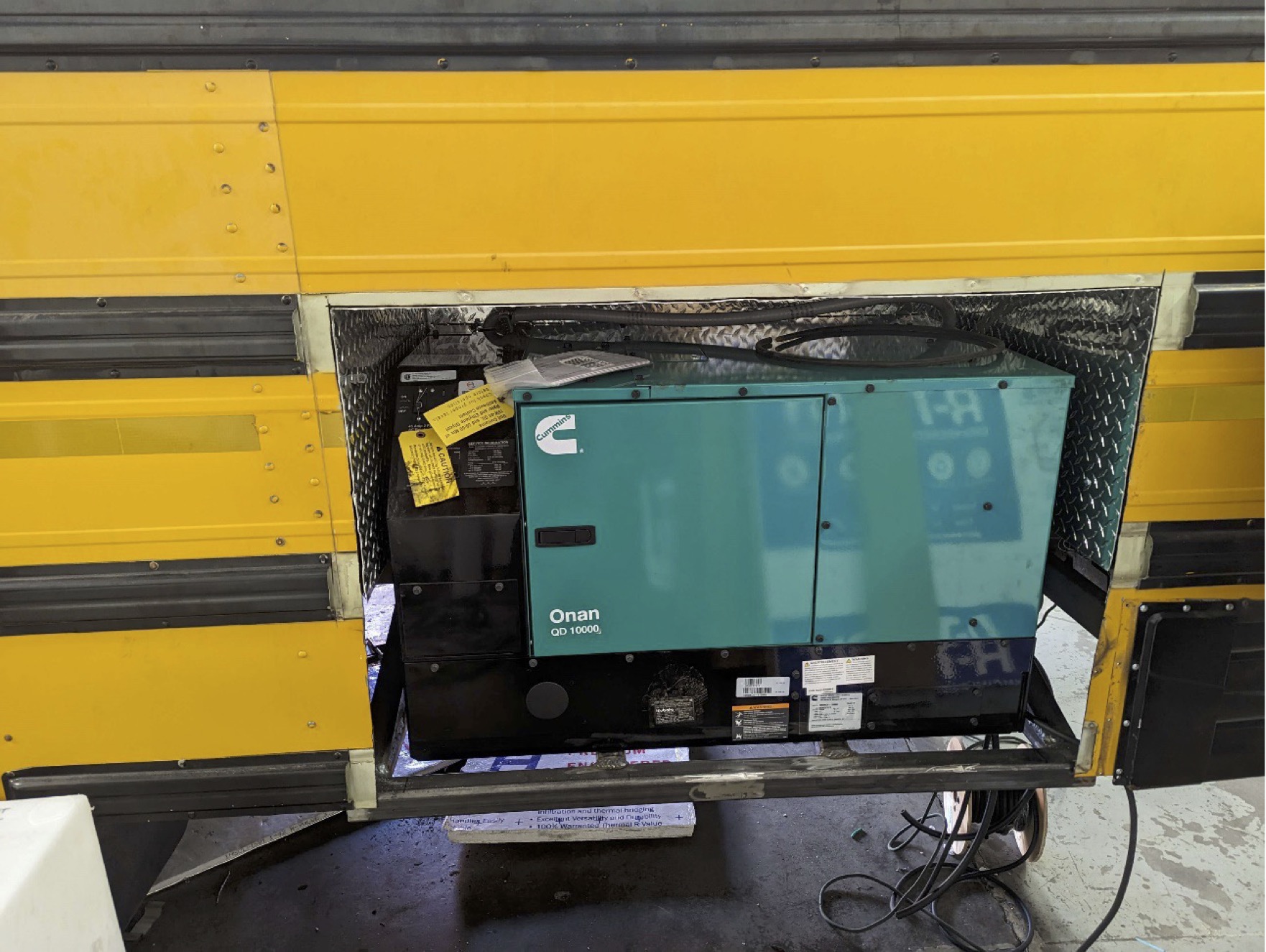
So there you have it, fellow food truck aficionados! Choosing the right generator for your food truck or food trailer build is no small feat. But armed with the knowledge of your power needs, the ability to calculate your total power draw, and a dash of humor, you’re well on your way to powering up your culinary dreams. Now go forth, conquer the open road, and serve up some deliciousness!

